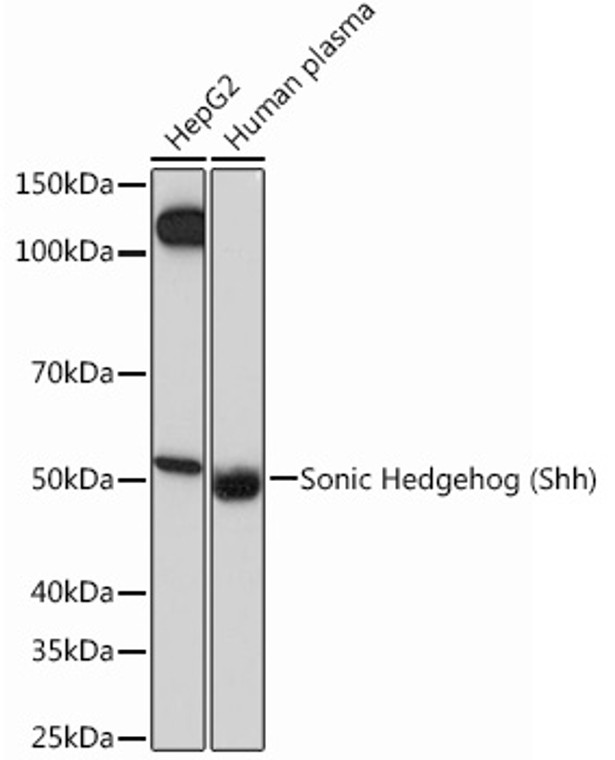| Host: |
Rabbit |
| Applications: |
WB/IF |
| Reactivity: |
Human/Mouse/Rat |
| Note: |
STRICTLY FOR FURTHER SCIENTIFIC RESEARCH USE ONLY (RUO). MUST NOT TO BE USED IN DIAGNOSTIC OR THERAPEUTIC APPLICATIONS. |
| Short Description: |
Rabbit monoclonal antibody anti-Sonic Hedgehog (200-300) is suitable for use in Western Blot and Immunofluorescence research applications. |
| Clonality: |
Monoclonal |
| Clone ID: |
S8MR |
| Conjugation: |
Unconjugated |
| Isotype: |
IgG |
| Formulation: |
PBS with 0.02% Sodium Azide, 0.05% BSA, 50% Glycerol, pH7.3. |
| Purification: |
Affinity purification |
| Dilution Range: |
WB 1:500-1:2000IF/ICC 1:50-1:200 |
| Storage Instruction: |
Store at-20°C for up to 1 year from the date of receipt, and avoid repeat freeze-thaw cycles. |
| Gene Symbol: |
SHH |
| Gene ID: |
6469 |
| Uniprot ID: |
SHH_HUMAN |
| Immunogen Region: |
200-300 |
| Immunogen: |
A synthetic peptide corresponding to a sequence within amino acids 200-300 of human Sonic Hedgehog (Shh) (Q15465). |
| Immunogen Sequence: |
PGSATVHLEQGGTKLVKDLS PGDRVLAADDQGRLLYSDFL TFLDRDDGAKKVFYVIETRE PRERLLLTAAHLLFVAPHND SATGEPEASSGSGPPSGGAL G |
| Post Translational Modifications | Sonic hedgehog protein: The C-terminal domain displays an autoproteolysis activity and a cholesterol transferase activity. Both activities result in the cleavage of the full-length protein and covalent attachment of a cholesterol moiety to the C-terminal of the newly generated N-terminal fragment (ShhN). Cholesterylation is required for the sonic hedgehog protein N-product targeting to lipid rafts and multimerization. ShhN is the active species in both local and long-range signaling, whereas the C-product (ShhC) is degraded in the reticulum endoplasmic. Sonic hedgehog protein N-product: N-palmitoylation by HHAT of ShhN is required for sonic hedgehog protein N-product multimerization and full activity. It is a prerequisite for the membrane-proximal positioning and the subsequent shedding of this N-terminal peptide. Sonic hedgehog protein N-product: The lipidated N- and C-terminal peptides of ShhNp can be cleaved (shedding). The N-terminal palmitoylated peptide is cleaved at the Cardin-Weintraub (CW) motif site. The cleavage reduced the interactions with heparan sulfate. The cleavage is enhanced by SCUBE2. |
| Function | Sonic hedgehog protein: The C-terminal part of the sonic hedgehog protein precursor displays an autoproteolysis and a cholesterol transferase activity. Both activities result in the cleavage of the full-length protein into two parts (ShhN and ShhC) followed by the covalent attachment of a cholesterol moiety to the C-terminal of the newly generated ShhN. Both activities occur in the reticulum endoplasmic. Once cleaved, ShhC is degraded in the endoplasmic reticulum. Sonic hedgehog protein N-product: The dually lipidated sonic hedgehog protein N-product (ShhNp) is a morphogen which is essential for a variety of patterning events during development. Induces ventral cell fate in the neural tube and somites. Involved in the patterning of the anterior-posterior axis of the developing limb bud. Essential for axon guidance. Binds to the patched (PTCH1) receptor, which functions in association with smoothened (SMO), to activate the transcription of target genes. In the absence of SHH, PTCH1 represses the constitutive signaling activity of SMO. |
| Protein Name | Sonic Hedgehog ProteinShhHhg-1Shh Unprocessed N-Terminal Signaling And C-Terminal Autoprocessing DomainsShhnc Cleaved Into - Sonic Hedgehog Protein N-ProductShhnShh N-Terminal Processed Signaling DomainsShhnp |
| Database Links | Reactome: R-HSA-373080Reactome: R-HSA-5358346Reactome: R-HSA-5362768Reactome: R-HSA-5362798Reactome: R-HSA-5632681Reactome: R-HSA-5632684Reactome: R-HSA-5635838Reactome: R-HSA-5658034Reactome: R-HSA-9758920Reactome: R-HSA-9796292 |
| Cellular Localisation | Sonic Hedgehog Protein: Endoplasmic Reticulum MembraneGolgi Apparatus MembraneSecretedCo-Localizes With Hhat In The Er And Golgi MembraneSonic Hedgehog Protein N-Product: Cell MembraneLipid-AnchorThe Dual-Lipidated Sonic Hedgehog Protein N-Product (Shhnp) Is Firmly Tethered To The Cell Membrane Where It Forms MultimersFurther Solubilization And Release From The Cell Surface Seem To Be Achieved Through Different MechanismsIncluding The Interaction With Disp1 And Scube2Movement By Lipoprotein ParticlesTransport By Cellular Extensions Called Cytonemes Or By The Proteolytic Removal Of Both Terminal Lipidated Peptides |
| Alternative Antibody Names | Anti-Sonic Hedgehog Protein antibodyAnti-Shh antibodyAnti-Hhg-1 antibodyAnti-Shh Unprocessed N-Terminal Signaling And C-Terminal Autoprocessing Domains antibodyAnti-Shhnc Cleaved Into - Sonic Hedgehog Protein N-Product antibodyAnti-Shhn antibodyAnti-Shh N-Terminal Processed Signaling Domains antibodyAnti-Shhnp antibodyAnti-SHH antibody |
Information sourced from Uniprot.org
12 months for antibodies. 6 months for ELISA Kits. Please see website T&Cs for further guidance










